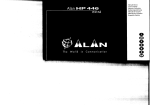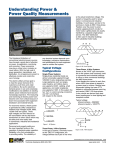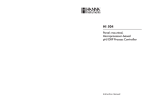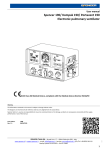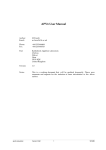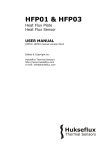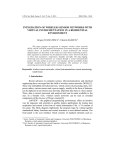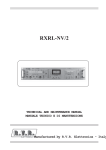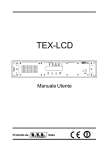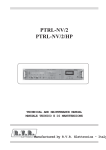Download PTRL & RXRL LCD - RVR Elettronica SpA Documentation Server
Transcript
PTRL & RXRL LCD User Manual Volume 1 Manufactured by Italy File name: CAPITOLI_EN.P65 Version: 1.2 Date: 31/01/2005 Revision History Date Version 12/01/04 1.0 02/06/04 1.1 31/01/05 1.2 Reason New Version PTRL LCD Rear Panel Upgrade Added Chapter 11 Editor J. Berti J. Berti J. Berti PTRL & RXRL LCD - User Manual Version 1.2 © Copyright 2003-2005 R.V.R. Elettronica SpA Via del Fonditore 2/2c - 40138 - Bologna (Italia) Telephone: +39 051 6010506 Fax: +39 051 6011104 Email: [email protected] Web: www.rvr.it All rights reserved Printed and bound in Italy. No part of this manual may be reproduced, memorized or transmitted in any form or by any means, electronic or mechanic, including photocopying, recording or by any information storage and retrieval system, without written permission of the copyright owner. Notification of intended purpose and limitations of product use This product is a FM transmitter intended for FM audio broadcasting. It utilises operating frequencies not harmonised in the intended countries of use. The user must obtain a license before using the product in intended country of use. Ensure respective country licensing requirements are complied with. Limitations of use can apply in respect of operating freuency, transmitter power and/or channel spacing. Declaration of Conformity Hereby, R.V.R. Elettronica SpA, declares that this FM transmitter is in compliance with the essential requirements and other relevant provisions of Directive 1999/5/EC. PTRL & RXRL LCD Table of Contents 1. 2. 3. 3.1 3.2 4. 5. 5.1 5.2 5.3 5.4 6. 6.1 6.2 6.3 6.4 7. 7.1 7.2 7.3 7.4 7.5 7.6 8. 8.1 8.2 8.3 8.4 9. 9.1 9.2 9.3 9.4 9.5 9.5 9.6 Preliminary Instructions Warranty First Aid Treatment of electrical shocks Treatment of electrical Burns General description PTRL-LCD quick guide for installation and use Preparation Use Settings and calibration Software RXRL-LCD quick guide for installation and use Preparation Use Settings and calibration Software External Description Front Panel of the PTRL LCD Rear pannel of the PTRL-LCD Description of the connectors Front pannel of the RXRL-LCD Rear pannel of the RXRL-LCD Description of the connectors Specifiche Tecniche Caratteristiche meccaniche Electrical characteristics of the PTRL LCD Electrical characteristics of the RXRL-LCD Electrical characteristics of the PTRL + RXRL-LCD Functioning principles of the PTRL-LCD Power supply Reducing card Pannel card Monitoring card Main card Power Amplifier Telemetry card User Manual Rev. 1.2 - 31/01/05 1 3 5 5 6 7 9 9 10 10 11 17 17 18 18 19 23 23 24 25 26 27 28 29 29 29 31 32 33 34 34 35 35 35 36 36 i PTRL & RXRL LCD 10. 10.1 10.2 10.3 10.4 10.5 10.6 10.7 11. 11.1 11.2 ii Functioning principles of the RXRL-LCD Power supply Power supply interface Panel card IF Card Front End VCO/PLL Telemetry card Procedure for change frequency of the radio link Introduction Frequency Alignment Rev. 1.2 - 31/01/05 37 38 38 39 39 39 40 40 41 41 41 User Manual PTRL & RXRL LCD 1. Preliminary Instructions This manual is written as a general guide for those having previous knowledge and experience with this kind of equipment, well conscious of the risks connected with the operation of electrical equipment. It is not intended to contain a complete statement of all safety rules which should be observed by personnel in using this or other electronic equipment. The installation, use and maintenance of this piece of equipment involve risks both for the personnel performing them and for the device itself, that shall be used only by trained personnel. R.V.R. Elettronica SpA doesn’t assume responsibility for injury or damage resulting from improper procedures or practices by untrained/unqualified personnel in the handling of this unit. Please observe all local codes and fire protection standards in the operations of this unit. WARNING: always disconnect power before opening covers or removing any part of this unit. Use appropriate grounding procedures to short out capacitors and high voltage points before servicing. WARNING: this device can irradiate radio frequency waves, and if it’s not installed following the instructions contained in the manual and local regulations it could generate interferences in radio communications. This is a "CLASS A" equipment. In a residential place this equipment can cause hash. In this case can be requested to user to take the necessary measures. R.V.R. Elettronica SpA reserves the right to modify the design and/or the technical specifications of the product and this manual without notice. User Manual Rev. 1.2 - 31/01/05 1 / 44 PTRL & RXRL LCD This page was intentionally left blank 2 / 44 Rev. 1.2 - 31/01/05 User Manual PTRL & RXRL LCD 2. Warranty Any product of R.V.R. Elettronica is covered by a 24 (twenty-four) month warranty. For components like tubes for power amplifiers, the original manufacturer’s warranty applies. R.V.R. Elettronica SpA extends to the original end-user purchaser all manufacturers warranties which are transferrable and all claims are to be made directly to R.V.R. per indicated procedures. Warranty shall not include: 1 Re-shipment of the unit to R.V.R. for repair purposes 2 Any unauthorized repair/modification; 3 Incidental/consequential damages as a result of any defect 4 Nominal non-incidental defects 5 Re-shipment costs or insurance of the unit or replacement units/parts Any damage to the goods must be reported to the carrier in writing on the shipment receipt. Any discrepancy or damage discovered subsequent to delivery, shall be reported to R.V.R. Elettronica within 5 (five) days from delivery date. To claim your rights under this warranty, you shold follow this procedure: 1 Contact the dealer or distributor where you purchased the unit. Describe the problem and, so that a possible easy solution can be detected. Dealers and Distributors are supplied with all the information about problems that may occur and usually they can repair the unit quicker than what the manufacturer could do. Very often installing errors are discovered by dealers. 2 If your dealer cannot help you, contact R.V.R. Elettronica and explain the problem. If it is decided to return the unit to the factory, R.V.R. Elettronica will mail you a regular authorization with all the necessary instructions to send back the goods. 3 When you receive the authorization, you can return the unit. Pack it carefully for the shipment, preferably using the original packing and seal the package perfectly. The customer always assumes the risks of loss (i.e., R.V.R. is never responsible for damage or loss), until the package reaches R.V.R. premises. For this reason, we suggest you to insure the goods for the whole value. Shipment must be effected C.I.F. (PREPAID) to the address specified by R.V.R.’s service manager on the authorization DO NOT RETURN UNITS WITHOUT OUR AUTHORIZATION AS THEY WILL BE REFUSED User Manual Rev. 1.2 - 31/01/05 3 / 44 PTRL & RXRL LCD 4 Be sure to enclose a written technical report where mention all the problems found and a copy of your original invoice establishing the starting date of the warranty. Replacement and warranty parts may be ordered from the following address. Be sure to include the equipment model and serial number as well as part description and part number. R.V.R. Elettronica SpA Via del Fonditore, 2/2c 40138 BOLOGNA ITALY Tel. +39 051 6010506 4 / 44 Rev. 1.2 - 31/01/05 User Manual PTRL & RXRL LCD 3. First Aid The personnel employed in the installation, use and maintenance of the device, shall be familiar with theory and practice of first aid.. 3.1 3.1.1 Treatment of electrical shocks If the victim is not responsive Follow the A-B-C's of basic life support • Place victim flat on his backon a hard surface. • Open airway: lift up neck, push forehead back (Fig. 3-1). • clear out mouth if necessary and observe for breathing • if not breathing, begin artificial breathing (Figure 3-2): tilt head, pinch nostrils, make airtight seal, four quick full breaths. Remember mouth to mouth resuscitation must be commenced as soon as possible Figure 3-1 • Figure 3-2 Check carotid pulse (Fig 3-3); if pulse is absent, begin artificial circulation (Fig. 3-4) depressing sternum (Fig. 3-5) Figure 3-3 Figure 3-4 Figure 3-5 • In case of only one rescuer, 15 compressions alternated to two breaths. • If there are two rescuers, the rythm shall be of one brath each 5 compressions. • Do not interrupt the rythm of compressions when the second person is giving breath. • Call for medical assistance as soon as possible. User Manual Rev. 1.2 - 31/01/05 5 / 44 PTRL & RXRL LCD 3.1.2 3.2 3.2.1 If victim is responsive • Keep them warm • Keep them as quiet as possible • Loosen their clothing (a reclining position is recommended) • Call for medical help as soon as possible Treatment of electrical Burns Extensive burned and broken skin • Cover area with clean sheet or cloth • Do not break blisters, remove tissue, remove adhered particles of apply any salve or ointment. • Treat victim for shock as required. • Arrange transportation to a hospital as quickly as possible. • If arms or legs are affected keep them elevated clothing, or If medical help will not be available within an hour and the victim is conscious and not vomiting, give him a weak solution of salt and soda: 1 level teaspoonful of salt and 1/ 2 level teaspoonful of baking soda to each quart of water (neither hot or cold). Allow victim to sip slowly about 4 ounces (half a glass) over a period of 15 minutes. Discontinue fluid if vomiting occurs DO NOT give alcohol 3.2.2 6 / 44 Less severe burns • Apply cool (not ice cold) compresses using the cleansed available cloth article. • Do not break blisters, remove tissue, remove adhered particles of clothing, or apply salve or ointment. • Apply clean dry dressing if necessary. • Treat victim for shock as required. • Arrange transportation to a hospital as quickly as possible • If arms or legs are affected keep them elevated. Rev. 1.2 - 31/01/05 User Manual PTRL & RXRL LCD 4. General description The PTRL-LCD and the RXRL-LCD are, respectively a broadband radio transmitter and receiver for the transport of audio signals as an auxiliary to the frequency modulation sound broadcasting. This type of equipment is often called STL (Studio-to-Transmitter Link). The PTRL-LCD is designed to work in an optimum way when connected to the receiver RXRL-LCD. Externally, it is a box to mount in a 19" rack, each one being 2HE high. The standard working frequency bands are the following: • 220 MHz ÷ 240 MHz (5KHz steps) • 420 MHz ÷ 440 MHz (5KHz steps) • 900 MHz ÷ 960 MHz (5KHz steps) The working frequency (and therefore the band) should be indicated when the order for such product is placed. WARNING: upon request, these links are available at other frequency bands and steps, please contactact RVR in order to check the availability of modules at the required frequency. The PTRL-LCD is available with internal stereo coder which can guarantee an optimum stereophonic separation as well as a low level of armonic distorsion. In function of your own requirements it can be configurated for the functioning under the Mono/MPX mode (that is to say when excluding the stereo coder and when using the "left" inputs as a "mono" input and the BNC, which is always on, as "MPX"). The configuration can be done by the user with the help of microswitches which can be selected from the outside. It has also two inputs (SCA1 and SCA2) for signals which are modulated on sub-carriers by appropriated external coders, normally used in Europe for the RDS transmission (Radio Data System). In the standard version of the RXRL-LCD, the demodulated signal is available in the MPX form (that is to say the complete basis signal band) and in the mono version. Moreover there are two connectors used for the respective SCA outputs. As an option, the RXRL-LCD can be equipped with a stereo decoder option. Also when this option is present, apart from the outputs for the LEFT and RIGHT channels, the outputs for the MPX signal are present and for the possible sub-carriers. The important audio characteristics of this equipment are the low distorsion and intermodulation values and the high S/N level; another important quality both of the PTRL-LCD and the RXRL-LCD is its very simple construction and its easy use. User Manual Rev. 1.2 - 31/01/05 7 / 44 PTRL & RXRL LCD Both the PTRL-LCD and the RXRL-LCD were designed in a modular way: the different functions are executed by modules connected directly with male and female connectors or with flat cables with connectors at both ends. This type of design makes the maintenance and the possible replacement of modules an easy operation. The microprocessor system includes an LCD display and series of push-buttons that enable the interaction with the user, and implements the following functionsfor the transmitter: • Setting of the output power • Setting of the working frequency • Activation and switch off of the power distribution • Measurement and display of the working parameters of the transmitter • Communication with external devices These functions are implemented for the receiver: • Display of the modulation • Setting of the working frequency • Setting of the muting • Measurement and display of the working parameters of the receiver • Communication with external devices The system of the management software is composed of several menus. The user can navigate between the different submenus by using four push-buttons: ESC, LEFT/HIGH, RIGHT/LOW, and ENTER. The status of the unit is indicated by four LEDs which are present on the front pannel: • ON, LOCK, FOLDBACK, RF MUTE for the PTRL LCD. • ON, LOCK, PILOT, MUTE for the RXRL LCD. Both the transmitter and the receiver have an input for the external 24 Vcc supply. This auxiliary supply source, that can be realized by the user with the help of rescuebatteries, is automatically used in case of AC voltage absence. 8 / 44 Rev. 1.2 - 31/01/05 User Manual PTRL & RXRL LCD 5. PTRL-LCD quick guide for installation and use This chapter contains the necessary instructions for the installation and use of the equipment. In case some aspects are not totally clear, for instance when a user is using this equipment for the first time, we advise the new user to read carefully the entire description contained in this manual. 5.1 Preparation Unpack the transmitter and check, before making any operation, that the unit has not suffered from any mishandling during transport. In particular check that all the connectors are in perfect conditions. Check that the supply voltage value coincides with the AC voltage available. The input supply field is of: • PTRL LCD 90-260 VAC Check that the switches of the PTRL-LCD are in the position "0" (off). The PTRL-LCD has 2 switches: one is included in the VDE socket for the AC supply cable and interrupts completely the AC supply of the unit, while the second is situated on the front pannel and his action is to inhibit the switching power supply of the unit. Connect the RF output of the exciter to the antenna cable or to a dummy load adapted for the working frequency and the power output used. Connect the AC cable to the corresponding VDE socket. REMARK: It is essential that the AC network has an accurrate grounding system in order to ensure both the safety of the users and the correct functioning of the unit. If the user intends to use external batteries in case of AC supply interruption, connect them to the clamps situated at the back of the equipment being careful to respect the polarity. WARNING: Keep in mind that the general switch of the transmitter has an effect on the AC supply, and not on the possible auxiliary supply. If you use an external supply with continuous current, it is then necessary to have an external switch for this purpose. Connect the audio cables of your own audio signal to the apropriate connectors situated at the back of the exciter. User Manual Rev. 1.2 - 31/01/05 9 / 44 PTRL & RXRL LCD 5.2 Use Switch on the transmitter by putting the selector on the position "I" (on) the switch situated on the pannel, and switch it on thanks to the switch situated on the front pannel. Enter the menu "Set" and set the working frequency desired. For the description of the different menus, read the chapter 5.4. With the help of the switches and trimmers situated on the rear pannel, set the characteristics (impedance, preenphasis, and possibly stereo/mono) and the levels of the audio inputs and RDS (if used). REMARK: When it comes out of the factory, the output power of the unit is regulated at the minimum and is setted on the OFF position. Anyway we always advise to check the setted level before you select the output power, especially when the unit is used as modulator of a power amplifier. From the predefined menu, set the desired power level. From the menu "Fnc", set the power output. 5.3 Settings and calibration The only regulations that should be done manually on the PTRL-LCD are the regulations of the levels and audio functioning modes. On the rear pannel of the unit there is a trimmer for each input of the exciter; the silkscrenn of the pannel indicated to which input each trimmer refers to. The sensitivity of the different inputs can be regulated with the trimmers as indicated in the following tables: • Sensitivity of the inputs Input MPX/RDS Chap. 7.2 [10] Trimmer [11] Sensitivity -20 ÷ +13 dBm SCA1 SCA2 Left Mono/MPX Right/Mono [9] [22] [26] [24] [23] [25] - 8 ÷ +13 dBm - 8 ÷ +13 dBm -13 ÷ +13 dBm [13] [12] -13 ÷ +13 dBm Notes Input level for 2.0 kHz (-30 dB) of deviation Input level for 7.5 kHz (-20 dB) of deviation Input level for75 kHz(0 dB) of deviation In order to regulate the sensitivity level of the inputs, it is important to keep in mind that the instantaneous modulation level is indicated in the predefined menu and that an indicator indicates that the level is at 75 kHz. For a correct regulation, we advise to bring a signal equivalent to the signal level of your own audio programme into the input of the unit and regulate the corresponding trimmer until the instantaneous deviation coincides with the 75 kHz indication. 10 / 44 Rev. 1.2 - 31/01/05 User Manual PTRL & RXRL LCD For the regulation of the levels of the sub-carriers' inputs, a similar procedure can be followed, with the help of the option "X10" which can be selected from the menu Fnc. With this option, the indicated modulation level is multiplied per the factor 10, so that the hachured indication of the predefined menu coincides with a deviation value of 7,5 kHz. As for the stereo version, there is an appropriate menu in which the levels of the right and left channels with the corresponding nominal level indicators for the maximum 75Khz deviation are indicated separately. The position of the DIP switches that are needed to select the available options is indicated on the silk-screen. Preenphasis (switch [7] Chap. 7.2): • ON 1 ON 2 • 3 4 50 µs 1 2 3 4 75 µs Impedance of L&R inputs (XLR type) (switch [27] Chap. 7.2): Switch 1: Impedance of R XLR ON input = 600 Ω, OFF = 10 kΩ Switch 2: Impedance of L XLR ON input = 600 Ω, OFF = 10 kΩ • Functioning modes / Impedance of MPX input ([8] Chap. 7.2): Switch 1: Functioning mode ON = Mono, OFF = Stereo Switch 2: impedance of MPX ON input = 50 Ω, OFF = 10 kΩ 5.4 Software The unit is equipped with an LCD display with 2 lines on which several menus are shown. A general view of the menus of the unit are shown in the illustration. On the left side of the display, depending on the case, one of the following symbols can be present: The parameter indicated by the arrow can be modified The arrow indicates the current line, whose parameter cannot be modified. This symbol is present in the menus composed of several lines as an help for the scrolling of the menus. When the unit is switched on, the LCD display shows the predefined view, with the graphical representation of the instantaneous modulation level and the indication of the value of the direct power erogated: User Manual Rev. 1.2 - 31/01/05 11 / 44 PTRL & RXRL LCD The vertical bars near the title "Mod" indicate the progress of the modulation in real time; the hachured bar indicates the maximum 75 kHz nominal modulation level (100%). In order to change the power level setted, select with the push-button GIU' the line which corresponds to the power and keep the ENTER button pressed until you enter the modify mode. The above line displays the instantaneous power reading (in this example 10W), while the bar indicates the setted level. In order to increase the level, keep the DESTRA/GIU' button pressed, in order to reduce it press the SINISTRA/SU' button. As the setted level increases or decreases, the bar gets longer or shorter in order to enable the display of the current setting. Once the desired level is reached, press ENTER to confirm and exit the predefined menu. Please note that the setted value is anyway memorized, therefore when you press ESC or when the timeout period is passed and no button was pressed, the power will remain on the last setted level. When you press twice on the ESC button while you are in the predefined menu, the following selection view is displayed, and from this view it will be then possible to enter to all the other menus: To enter one of the submenus, select the name (that will be enhanced by a flashing cursor) with the RIGHT or LEFT push-buttons and then press the ENTER button. If on the contrary, you wish to return to the predefined menu, you just have to press again the ESC push-button. In some cases, on the left side of the menu an arrow can appear. It means that it is necessary to indicate the current line selected. When the arrow is full, the parameter can be modified, while when it is empty, the parameter can only be viewed. REMARK: The "L&R" menu is available only in the stereo version. In the mono version the "L&R" inscription do not appear. 5.4.1 Functioning menu (Fnc) From this menu the user can set the deviation display mode, he can switch on or inhibit the power erogation of the transmitter and he can modify the attention threshold. 12 / 44 Rev. 1.2 - 31/01/05 User Manual PTRL & RXRL LCD In order to intervene on one of the three keys, select the corresponding line with the "UP" and "DOWN" buttons and then press and keep the ENTER button pressed until the order is accepted. In this way the Pwr setting will go from On to Off or viceversa and the Mod setting will go from "X1" to "X10" or viceversa. In "X10" mode the indication of the instantaneous deviation is multiplied by 10, this is why the hachured indicator on the predefined menu coincides with the 7,5 kHz value instead of 75 kHz. This visualization mode is useful when the user wants to have low deviation levels displayed, for instance when they are provoked by the pilot tone or the subcarriers. As indicated in the introduction, the transmitter offers the possibiliy to the user to set the attention threshold. This latter is compared to the level of one of the functioning parameters of the unit. The result of the comparison is available on the telemetry connector, and can be read on the display as "O" (which means open, that is to say the result is wrong) or "C" (which means closes, therefore the result is true). The threshold that can be setted (Power Good) refers to the transmitted power level. The threshold is expressed in percentage of the full scale of the considered size. The full-scale of the monitored size of the attention threshold for the PTRL-LCD is: • Forward Power 10 W In order to change the values of the attention thresholds, the following procedure should be followed: • Select the line that should be modified (with the 'UP' and 'DOWN' buttons) • Press the ENTER button • Modify the value of the threshold ('UP' and 'DOWN' buttons) • Press the ENTER button In this example, the alarm threshold is: • 5.4.2 PwG 9W (90% x 10 W) Pwr menu (Pwr) This view shows to the user the measurements corresponding to the power erogation of the exciter: • Forward Power (Fwd ) • Reflected Power (Rfl) User Manual Rev. 1.2 - 31/01/05 13 / 44 PTRL & RXRL LCD The values indicated are "readings", and therefore cannot be modified (remark the empty triangle). In order to modify the power setting, use the predefined menu as described formerly. 5.4.3 Power Amplifier menu (P.A) This view, composed of three lines that can be scrolled with the 'UP' and 'DOWN' buttons, shows to the user the values corresponding to the power amplifier of the unit: 5.4.4 • Voltage (VPA) • Absorbed current (IPA) Menù Impostazioni (Set) This menu enables to read and set the working frequencies. When you press the ENTER button, it will be possible to modify the setted frequency with the 'UP' (the frequency increases) and 'DOWN' (the frequency decreases). After a new frequency value was setted, press the ENTER button to confirm the choice; the exciter will unlock from the current frequency (the LED LOCK switches off) and will lock to the new working frequency (the LOCK LED lits up). On the contrary when you press ESC or when you let the timeout passes by, the frequency will remain setted at the last value memorized. 5.4.5 Mix menu (Mix) This menu enables to set the path of the unit on a serial bus connection of the type I2C: The I2C AC path is important when the exciter is connected to an RVR transmission system which allows the use of this protocol. We recommend not to modify it with no reason. 14 / 44 Rev. 1.2 - 31/01/05 User Manual PTRL & RXRL LCD 5.4.6 Versions Menu (Vrs) zThis view shows the version of the unit and the date to the software release. 5.4.7 Channels menu (L&R) This menu works on stereo version units. The input levels of the right and left channels are represented by vertical bars as indicated in the following illustration. The hachured bar indicates the level which corresponds to the global deviation of 100% of the channels. User Manual Rev. 1.2 - 31/01/05 15 / 44 PTRL & RXRL LCD Pagina lasciata intenzionalmente in bianco 16 / 44 Rev. 1.2 - 31/01/05 User Manual PTRL & RXRL LCD 6. RXRL-LCD quick guide for installation and use This chapter contains the necessary instructions for the installation and use of the equipment. In case some aspects are not totally clear, for instance when a user is using this equipment for the first time, we advise the new user to read carefully the entire description contained in this manual. 6.1 Preparation Unpack the transmitter and check, before making any operation, that the unit has not suffered from any mishandling during transport. In particular check that all the connectors are in perfect conditions. Check that the supply voltage value coincides with the AC voltage available. The input supply field is of: • RXRL LCD 85-264 VAC Check that the switches of the RXRL-LCD are in the position "0" (off). The RXRL-LCD has a switch which interrupts completely the AC supply of the unit. Connect the RF output of the exciter to the antenna cable . Connect the AC cable to the corresponding VDE socket. REMARK: It is essential that the AC network has an accurrate grounding system in order to ensure both the safety of the users and the correct functioning of the unit. If the user intends to use external batteries in case of AC supply interruption, connect them to the clamps situated at the back of the equipment being careful to respect the polarity. WARNING: Keep in mind that the general switch of the transmitter has an effect on the AC supply, and not on the possible auxiliary supply. If you use an external supply with continuous current, it is then necessary to have an external switch for this purpose. Connect the audio cables of your own audio signal to the apropriate connectors situated at the back of the exciter User Manual Rev. 1.2 - 31/01/05 17 / 44 PTRL & RXRL LCD 6.2 Use Switch on the receiver by putting the selector on the position "I" (on) the switch situated on the rear pannel. Enter the menu "Set" and set the working frequency desired. For the description of the different menus, read the chapter 6.4. With the help of the switches and trimmers situated on the rear pannel, set the characteristics (deenphasis) and the levels of the audio outputs. From the predefined menu, set the desired power level. From the menu "Fnc", set the power output 6.3 Settings and calibration The only regulations that should be done manually on the RXRL-LCD are the regulations of the levels and audio functioning modes. On the rear pannel of the unit there is a trimmer for each output of the receiver. The sensitivity of the different outputs can be regulated with the trimmers as indicated in the following tables: • Sensitivity of the inputs Output MPX Chap. 7.5 [13] Trimmer [14] Sensitivity -20 ÷ +13 dBm SCA SCA/MPX Left Mono/MPX Right/Mono [5] [4] [17] [6] [15] [16] - 8 ÷ +13 dBm - 8 ÷ +13 dBm -10 ÷ +14 dBm [8] [7] -10 ÷ +14 dBm Notes Output level for 2.0 kHz (-30 dB) of deviation Output level for 7.5 kHz (-20 dB) of deviation Output level for 75 kHz(0 dB) of deviation In order to regulate the sensitivity level of the inputs, it is important to keep in mind that the instantaneous modulation level is indicated in the predefined menu and that an indicator indicates that the level is at 75 kHz. For a correct regulation, we advise to bring a signal equivalent to the signal level of your own audio programme into the input of the unit and regulate the corresponding trimmer until the instantaneous deviation coincides with the 75 kHz indication. For the regulation of the levels of the sub-carriers' outputs, a similar procedure can be followed, with the help of the option "X10" which can be selected from the menu Fnc. With this option, the indicated modulation level is multiplied per the factor 10, so that the hachured indication of the predefined menu coincides with a deviation value of 7,5Khz. 18 / 44 Rev. 1.2 - 31/01/05 User Manual PTRL & RXRL LCD As for the stereo version, there is an appropriate menu in which the levels of the of the right and left channels with the corresponding nominal level indicators for the maximum 75Khz deviation are indicated separately. The position of the DIP switches that are needed to select the available options is indicated on the silk-screen. • Deenphasis (switch [18] Chap. 7.5): 50 µs 6.4 75 µs Software The unit is equipped with an LCD display with 2 lines on which several menus are shown. A general view of the menus of the unit are shown in the illustration. On the left side of the display, in function of the cases, one of the following symbols can be present: The parameter indicated by the arrow can be modified The arrow indicates the current line, whose parameter cannot be modified. This symbol is present in the menus composed of several lines as an help for the scrolling of the menus. When the unit is switched on, the LCD display shows the predefined view, with the graphical representation of the instantaneous modulation level and the indication of the value of the direct power erogated: The vertical bars under the key "Mod" indicate the progress of the modulation in real time; the hachured bar indicates the maximum 75 kHz nominal modulation level (100%). The above line displays the instantaneous reading of the signal level received on analog scale, while the bar indicates the setted level. In order to increase the level, keep the RIGHT/DOWN button pressed, in order to reduce it press the LEFT/UP button. As the setted level increases or decreases, the bar gets longer or shorter in order to enable the display of the current setting. Once the desired level is reached, press ENTER to confirm and exit the predefined menu. Please note that the setted value is anyway memorized, therefore when you press ESC or when the timeout period is passed and no button was pressed, the power will remain on the last setted level. User Manual Rev. 1.2 - 31/01/05 19 / 44 PTRL & RXRL LCD When you press twice on the ESC button while you are in the predefined menu, the following selection view is displayed, and from this view it will be then possible to enter to all the other menus: To enter one of the submenus, select the name (that will be enhanced by a flashing cursor) with the RIGHT or LEFT push-buttons and then press the ENTER button. If on the contrary, you wish to return to the predefined menu, you just have to press again the ESC push-button. In some cases, on the left side of the menu an arrow can appear. It indicates that it is necessary to indicate the current line selected. When the arrow is full, the parameter can be modified, while when it is empty, the parameter can only be viewed. 6.4.1 Functioning menu (Fnc) From this menu the user can set the deviation display mode, he can switch on or inhibit the muting mode. In order to intervene on one of the three keys, select the corresponding line with the "UP" and "DOWN" buttons and then press and keep the ENTER button pressed until the order is accepted. In this way the Pwr setting will go from On to Off or viceversa and the Mod setting will go from "X1" to "X10" or viceversa. In "X10" mode the indication of the instantaneous deviation is multiplied by 10, this is why the hachured indicator on the predefined menu coincides with the 7,5 kHz value instead of 75 kHz. This visualization mode is useful when the user wants to have low deviation levels displayed, for instance when they are provoked by the pilot tone or the subcarriers. As indicated in the introduction, the transmitter offers the possibiliy to the user to set the muting mode. "MUTE OFF" indicates that the muting was not activated, therefore the received signal is situated at the audio outputs. "MUTE ON" indicates that the muting is activated, therefore the audio outputs are muted. 20 / 44 Rev. 1.2 - 31/01/05 User Manual PTRL & RXRL LCD 6.4.2 Set menu (Set) This menu enables to read and set the working frequencies . When you press the ENTER button, it will be possible to modify the setted frequency with the 'UP' (the frequency increases) and 'DOWN' (the frequency decreases). After a new frequency value was setted, press the ENTER button to confirm the choice; the exciter will unlock from the current frequency (the LED LOCK switches off) and will lock to the new working frequency (the LOCK LED lits up). On the contrary when you press ESC or when you let the timeout passes by, the frequency will remain setted at the last value memorized. 6.4.3 Aud menu (Aud) The levels of the inputs of the left and right channels are represented by vertical bars as indicated in the following illustration. The hachured bar indicates the level which corresponds to the global deviation of 100% of the channels. 6.4.4 Mix menu (Mix) This menu enables to set the path of the unit on a serial bus connection of the type I2C: The I2C AC path is important when the exciter is connected to an RVR transmission system which allows the use of this protocol. We recommend not to modify it with no reason. User Manual Rev. 1.2 - 31/01/05 21 / 44 PTRL & RXRL LCD 6.4.5 Versions menu (Vrs) This view shows the version of the unit and the date to the software release. 22 / 44 Rev. 1.2 - 31/01/05 User Manual PTRL & RXRL LCD 7. External Description This chapter describes the elements which are present on the front and rear pannel of the PTRL-LCD and the RXRL-LCD. 7.1 Front Panel of the PTRL LCD Figure 7.1 [1] AIR FLOW [2] ON [3] LOCK [4] FOLDBACK [5] R.F. MUTE [6] CONTRAST [7] ESC [8] SINISTRA/SU’ [9] DESTRA/GIU’ [10] ENTER [11] DISPLAY [12] POWER User Manual Grid for the air flow Green LED, illuminato when the transmitter is feeded If it is on, indicates that the PLL is locked at the reference frequency yellow LED, if it is flashing, it indicates the intervention of the foldback function (automatic reduction of the erogated power) If it is flashing, it indicates that the exciter is not erogating power because it is inhibitted by an external interlock Regulation Trimmer of the contrast of the display Push-button to press to exit from a menu Push-button for the navigation in the system composed of several menus and for the modification of the parameters Push-button for the navigation in the system composed of several menus and for the modification of the parameters Push-button for the confirmation of a parameter and to enter the menus Liquid crystal display ON/OFF switch. It switches off the exciter without disconnecting the AC supply Rev. 1.2 - 31/01/05 23 / 44 PTRL & RXRL LCD 7.2 Rear pannel of the PTRL-LCD Figure 7.2 [1] P.A BLOCK [2] R.F. OUTPUT [3] INTERLOCK [4] FWD EXT. AGC [5] RFL EXT. AGC [6] PHASE ADJ [7] PREENPHASIS [8] MODE/MPX IMP [9] [10] [11] [12] [13] [14] [15] SCA 1 MPX/RDS MPX/RDS ADJ RIGHT/MONO ADJ RIGHT/MONO PLUG 24VDC IN [16] [17] [18] [19] [20] FAN R.F. TEST POINT REMOTE EXT REF 10MHz RS232 [21] 19 KHZ PILOT [22] [23] [24] [25] [26] [27] 24 / 44 SCA 2 SCA2 ADJ SCA1 ADJ LEFT-MONO/MPX ADJ LEFT-MONO/MPX IMPEDANCE Fuse-holder. Contains the protection fuse for the 3,15 A.power supply RF Output connector N type, 50Ω. BNC interlock connector: When the main conductor is grounded, the transmitter is forced to go in stand-by mode. Trimmer for the control of the erogated power in function of the FWD Fold input Trimmer for the control of the erogated power in function of the RFL Fold input Trimmer for the regulation of the pilot tone phase. Dip-switch for the setting of the preenphasis 50 or 75 µs. The preenphasis has an influence on the right and left inputs in stereo and on the mono input. The MPX inputs are not influenced by the setting of the preenphasis. Dip-switch for the selection both of the transmission mode (STEREO or MONO) and the impedance of the MPX input MPX, selectable at 50Ω or 10kΩ. BNC connector of the unbalanced SCA1 input. BNC connector of the unbalanced MPX input. Trimmer for the regulation of the levels of the MPX input. Trimmer for the regulation of the levels of the Right input. XLR connector for the input of the Right audio channel. AC voltage plug, 90-260V 50-60Hz. Connectors for the external 24V supply . Positive (red) or negative (black). Blower for the forced cooling. -30dB output at the output power level. DB15 connector for the telemetry of the device. Not used (reserved for future applications) DB9 connector for the interface with other equipment and programmation made by the factory. BNC output connector for the pilot tone, which can be used for the synchronisation of the external devices such as RDS coder, etc… BNC connector for the SCA2 input Trimmer for the regulation of the SCA2 input levels. Trimmer for the regulation of the SCA1 input levels. Trimmer for the regulation of the LEFT-MONO input levels. XLR connector for the LEFT-MONO audio channel input. Dip-switch for the selection of the impedance of the balanced audio inputs, selectable at 600Ω or 10kΩ. Rev. 1.2 - 31/01/05 User Manual PTRL & RXRL LCD 7.3 7.3.1 Description of the connectors RS 232 Type: DB9 female 1 7.3.2 6 1 2 3 4 5 6 7 8 9 NC TX_D RX_D Internally connected to 6 GND Internally connected to 4 Internally connected to 8 Internally connected to 7 NC Remote Type: DB15 female 1 7.3.3 9 1 2 3 4 5 6 7 8 9 10 11 12 13 14 15 Interlock FWD fold GND SDA IIC Bus VPA Tlm FWD tlm Power Good GND GND RFL fold SCL IIC Bus IPA Tlm RFL Tlm On cmd OFF cmd Left (MONO) / Right (MPX) Type: XLR female 2 1 3 User Manual 1 2 3 GND Positive Negative Rev. 1.2 - 31/01/05 25 / 44 PTRL & RXRL LCD 7.4 Front pannel of the RXRL-LCD Figure 7.4 [1] AIR FLOW [2] ON [3] LOCK [4] PILOT [5] MUTE [6] CONTRAST [7] ESC [8] SINISTRA/SU’ [9] DESTRA/GIU’ [10] ENTER [11] DISPLAY [12] POWER 26 / 44 Grid for the air flow Green LED, illuminato when the transmitter is feeded If it is on, indicates that the VCO is locked at the reference frequency yellow LED, if it is flashing, it indicates that there is a disfunction in the demodulated signal. yellow LED, if it is flashing, it indicates that the muting is activated, which means that the input signal has decreased under the defined threshold Regulation Trimmer of the contrast of the display Push-button to press to exit from a menu Push-button for the navigation in the system composed of several menus and for the modification of the parameters Push-button for the navigation in the system composed of several menus and for the modification of the parameters Push-button for the confirmation of a parameter and to enter the menus Liquid crystal display ON/OFF switch. It switches off the exciter without disconnecting the AC supply Rev. 1.2 - 31/01/05 User Manual PTRL & RXRL LCD 7.5 Rear pannel of the RXRL-LCD Figure 7.4 [1] MAINS VOLTAGE [2] R.F. INPUT 50 Ω [3] MUTE [4] [5] [6] [7] [8] [9] SCA/MPX OUT SCA OUT SCA OUT ADJ RIGHT/MONO ADJ MONO/RIGHT 24VDC IN [10] REMOTE [11] RS232 [12] [13] [14] [15] [16] [17] [18] User Manual 10.7 MHz IF OUT MPX OUT MPX OUT ADJ SCA/MPX OUT ADJ MONO/LEFT ADJ MONO/LEFT DEENPHASIS Plug for the AC voltage, 85-264V 50-60Hz. RF input connector N type, 50Ω. BNC interlock connector for the muting of the audio outputs with an external command. BNC connector for the unbalanced SCA or MPX output. BNC connector, for the unbalanced SCA OUT output. Trimmer for the regulation of the SCA OUT output. Trimmer for the regulation of the RIGHT/MONO output levels. XLR connector for the audio channel Mono or Right output. Connectors for the external 24V power supply. Positive (red) and negative (black). DB15 connector for the telemetry of the device. DB9 connector for the interface with other devices and for the programmation made by the factory. BNC output connector for the 10.7 MHz sampling for tests. BNC output connector for the unbalanced MPX. Trimmer for the regulation of the MPX OUT input levels. Trimmer for the regulation of the SCA/MPX input levels. Trimmer for the regulation of the MONO/LEFT input levels. XLR connectors for the MONO or LEFT audio channel input. Dip-switch for the setting of the deenphasis 50 or 75 ms. The deenphasis has an influence on the right and left outputs in stereo mode and on the mono input. The MPX outputs are not influenced by the setting of the preenphasis. Rev. 1.2 - 31/01/05 27 / 44 PTRL & RXRL LCD 7.6 7.6.1 Description of the connectors RS 232 Type: DB9 female 1 7.6.2 6 1 2 3 4 5 6 7 8 9 NC TX_D RX_D Internally connected to 6 GND Internally connected to 4 Internally connected to 8 Internally connected to 7 NC Remote Type: DB15 female 1 7.6.3 9 1 2 3 4 5 6 7 8 9 10 11 12 13 14 15 Interlock FWD fold GND SDA IIC Bus VPA Tlm FWD tlm Power Good GND GND RFL fold SCL IIC Bus IPA Tlm RFL Tlm On cmd OFF cmd Left (MONO) / Right (MPX) Type: XLR female 2 3 28 / 44 1 1 2 3 GND Positive Negative Rev. 1.2 - 31/01/05 User Manual PTRL & RXRL LCD 8. Specifiche Tecniche 8.1 Caratteristiche meccaniche Dimensions of the panel Depth Weight Working temperature 8.2 483 mm (19”) x 88 mm (3 1/2”) (2 HE) 344 mm (26 1/2”) About 6 Kg -10 °C ÷ 50 °C Electrical characteristics of the PTRL LCD General RFoutput power RF output connector RF output impedance Frequency band 0-10 W continuously selectable Type "N" 50 Ohm 220 ÷ 240 MHz 420 ÷ 440 MHz 900 ÷ 960 MHz (Other frequency bands are available unpon request, please contact RVR to know the availability of modules for the required frequency) Programmation of the frequency Direct through software Frequency stability ±1ppm from -10°C to 50°C Type of modulation Direct modulation of the carrier Supression of the spuries and harmonics Respect or exceed the FCC & CCIR (typical 75 dB) Ability of modulation Respect or exceed the FCC & CCIR (typical 240khz MPX or Mono, 210 KHz Stereo) Asynchronous modulation AM residual -70 dB or inferior against 100% AM, without deenphasis Synchronous modulation AM residual ≅ -50 dB or inferior against 100% AM, FM modulation 75 kHz at 400Hz, without deenphasis Transitory intermodulation distorsion < 0.1% (typical 0.05%)measured with square wave at 3.18 kHz and sinusoidal at 15 kHz with a 75 kHz FM A.C. supply ≅ 80 V ÷ 260 V, full-range C.C. supply 24 V Consumption 120 VA ca. Inputs Left-Mono/MPX input Right/Mono input MPX/RDS input Input Impedance Input Level Preemphasis User Manual XLR female type balanced or unbalanced XLR female type balanced or unbalanced BNC type unbalanced 10 kOhm or 600 Ohm, selectable through DIP-switch -20 dBm ÷ +13 dBm , continuous fine regulation by trimmer Selectable: 0 50 us (CCIR) 75 us (FCC) Rev. 1.2 - 31/01/05 29 / 44 PTRL & RXRL LCD SCA1 and SCA2 inputs 2 connectors BNC type unbalanced IImpedance of the SCA1 and SCA2 inputs 10 kOhm Level of the SCA1 and SCA2 inputs -20 dBm ÷ +13 dBm for a 2,0 kHz deviation adjustable by trimmer Outputs RF Out: standard connector "N" type with impedance 50 Ohm BNC connector approx. level -30 dB against the RF output, impedance 50 Ohm 1 Vpp minimum load 4.7 kOhm RF Test Tono pilota 19 KHz MONO Functioning S/N FM (200 MHz) S/N FM (400 MHz) S/N FM (900 MHz) Amplitude response /frequency Total armonics distorsion (THD) > 80dB against a 75KHz deviation with a 50 us deenphasis, detector RMS at 400 Hz > 75dB against a 75KHz deviation with deenphasis 50 us, detector RMS at 400MHz > 80dB against a 75KHz deviation with a 50 us deenphasis, detector RMS at 400 Hz ± 0.3 dB, 40 Hz ÷ 15 KHz ≤ 0.08% MPX Functioning Composite FM S/N > against 75KHz measured in the 40 Hz ¸ 75 KHz band with deenphasis 50 us, detector RMS Amplitude response /MPX frequency MPX ± 0.3 dB, 40 Hz ÷ 75 KHz Armonic distorsion total MPX ≤ 0.08 % Stereo Functioning S/N FM (200 MHz) S/N FM (400 MHz) S/N FM (900 MHz) Amplitude response /Audio frequency Total armonics distorsion > 73dB against a 75KHz deviation with a deenphasis 50 us, detector RMS at 400 Hz > 70dB against a 75KHz deviation with deenphasis 50 us, detector RMS at 400MHz > 67dB against a 75KHz deviation with 50 us deenphasis, detector RMS at 400 Hz ± 0.3 dB, 40 Hz ÷ 15 KHz ≤ 0.08 % Remote Connections Interlock connector Serial Interface Telemetry connector 30 / 44 BNC type, inhibits the power erogation when it is short-circuited Female DB9 RS232 Type female DB15, provides indications on the status of the unit Rev. 1.2 - 31/01/05 User Manual PTRL & RXRL LCD 8.3 Electrical characteristics of the RXRL-LCD General RF output connector RF output impedance Frequency band RF input impedance Frequency programmation Frequency stability Maximum RF input signal Intermediary Frequencies A.C. supply C.C. supply Type "N" 50 Ohm 220 ÷ 240 MHz 420 ÷ 440 MHz 900 ÷ 960 MHz (Other frequency bands are available unpon request, please contact RVR to know the availability of modules for the required frequency) 50 Ohm Direct through software ±1ppm from -10°C to 50°C +23 dBm 10,7 MHz, 700 KHz ≅ 85 V ÷ 264 V, full-range 24 V Outputs Mono/Right Ouput XLR female type balanced or unbalanced Mono/Left Output XLR female type balanced or unbalanced MPX OUT output BNC type unbalanced Output impedance 10 kOhm or 600 Ohm, selectable by DIPswitch Output level -20 dBm ÷ +13 dBm , fine continuous regulation by trimmer Deemphasis Selectable: 0 50 us (CCIR) 75 us (FCC) SCA OUT and SCA/MPX outputs 2 unbalanced connectors BNC type Impedance of the SCA OUT & SCA/MPX outputs 10 kOhm Level of the SCA OUT & SCA/MPX outputs -20 dBm ÷ +13 dBm for a 2,0 kHz deviation adjustable by trimmer 10.7 MHz IF OUT BNC type connector Inputs RF Input standard connector "N" type with 50 Ohms impedance MONO Functioning S/N FM User Manual > 68dB against a 75KHz deviation with 50 us deenphasis, detector RMS at 400 Hz Rev. 1.2 - 31/01/05 31 / 44 PTRL & RXRL LCD Amplitude response /frequency Total armonic distorsion (THD) ± 0.3 dB, 40 Hz ÷ 15 KHz ≤ 0.4% MPX Functioning Composite S/N FM Amplitude response /frequency MPX Total armonic MPX distorsion > 68 dB against a 75KHz measured in the 40 Hz ¸ 75 KHz band with deenphasis 50 us, detector RMS ± 0.3 dB, 40 Hz ÷ 75 KHz ≤ 0.4 % Stereo Functioning S/N FM Amplitude response /audio frequency Total armonic distorsion > 62 dB against a 75KHz deviation with deenphasis 50 us, detector RMS at 400 Hz ± 0.3 dB, 40 Hz ÷ 15 KHz ≤ 0.4 % Remote connections Mute connector Serial interface Telemetry connector BNC type, inhibits the power erogation when it is short-circuited Female DB9 RS232 DB15 type female, supplies indications on the status of the unit 8.4 Electrical characteristics of the PTRL + RXRL-LCD Mono Functioning S/N FM Total armonic distorsion (THD) > 65dB against a 75KHz measured in the 40 Hz ¸ 15KHz band with deenphasis 50 us, detector RMS ≤ 0.4% MPX Functioning Total armonic distorsion (THD) ≤ 0.4% Stereo Functioning S/N FM Total armonic distorsion (THD) 32 / 44 > 60dB against a 75KHz measured in the 40 Hz ¸ 15KHz band with deenphasis 50 us, detector RMS ≤ 0.4% Rev. 1.2 - 31/01/05 User Manual PTRL & RXRL LCD 9. Functioning principles of the PTRL-LCD The PTRL-LCD is composed of several modules connected between them with the help of connectors, with the aim to ease the maintenance and the possible replacement of the modules. The above description shows the top view of the unit with the indication of the different components. [1] [2] [3] [4] [5] [6] [7] User Manual VCO/PLL/AUDIO IN Card Telemetry card Power Amplifier Power Supply Card Pannel Card Monitoring card Reducing card Rev. 1.2 - 31/01/05 33 / 44 PTRL & RXRL LCD A schematic view of the modules and of the connections which compose the PTRLLCD is shown in the following illustration. PANEL CARD MAIN CARD POWER AMPLIFIER CONTROL CARD REDUCING CARD 24V-12V POWER SUPPLY RF CONNECTION DC CONNECTION A brief description of the functions of each module will follow, while the complete schemes and the layouts of the cards are shown in the appendix. 9.1 Power supply The power supply of the PTRL-LCD is a switching unit whose 24V main output will formerly be reduced in order to supply the RF stage of the unit. The stabilizers for the 5V and 18V continuous voltage generation for the supply of the other circuits of the unit are present on the power supply. Please note that the power supply is "direct from the AC line", therefore without transformer, and it can be connected to any of the voltages comprised between 100 and 230 V without making any regulations or manual settings. The auxiliary 24V continuous voltage inputs are connected to the power supply and intervene automatically in order to collide with possible AC supply absences. 9.2 Reducing card The reducing card transforms the voltage, coming from the switching power supply, from 24V to 12 V which is the necessary voltage for the supply of the RF power stage of the unit. 34 / 44 Rev. 1.2 - 31/01/05 User Manual PTRL & RXRL LCD 9.3 Pannel card The pannel card contains the microprocessor (PIC16F877Q) which implements the monitoring software of the unit, the display and the other elements which are necessary for the interface with the user. This card is the interface with the other modules of the unit, both for the distribution of the supply units and monitoring and for the measurements. 9.4 Monitoring card The monitoring card provides for the management of the readings and the regulation of the parameters referring to the direct and forward power, monitors the gain and the "FOLDBACK" input and it surveys the internal temperature of the unit. The card works as an interface between the panel card and the final stage for the power regulation, the protection, the readings and the remote monitorings. 9.5 Main card The main card has the following functions: • Processing of the audio and SCA inputs • Generation of the carrier • Modulation • R.F. Amplifier (Driver) The difference between the Mono and Stereo versions of this card is the audio stage, since the stereo version contains a stereophonic coder. 9.5.1 Audio input stage (mono version) The audio input stage contains the circuits which realize the following functions: 9.5.2 • Selection of the input impedance • 15 kHz filtering of the mono channel • Preenfasis of the mono channel • Mixing of the mono, MPX and SCA channels • Clipper (limits the level of the modulating signal so that the frequency deviation does not exceed the 75 kHz level) • Measurement of the modulating signal Audio input stage (stereo version) Two 15Khz filters are present in this card for the filtering of both Left and Right channels, and an integrated stereophonical generator. The other functions are the same in the mono version. User Manual Rev. 1.2 - 31/01/05 35 / 44 PTRL & RXRL LCD 9.5.3 PLL/VCO stage This stage of the card generates the modulated radiofrequency signal. It is based on a PLL scheme which uses an integrated PLL model MB15E06. 9.5.4 Driver stage Before going through the final stage (power amplifier), the RF signal is preamplified in this stage by the BFR540 transistor. When the exciter is in stand-by, the driver is inhibited. 9.5 Power Amplifier The power stage is mounted on a heatsink which enables the dissipation of the generated heat which is contained in a totally shielded metallic box fixed in the central part of the bottom back of the unit. The RF signal coming from the VCO at a level of around 10mW reaches the pilot stage (BFR96) and is amplified from the final stage (BGY925) up to 10W. The signal goes through a low-pass filter which provides the elimination of the armonic emissions. A directional coupler enables the reading of the direct and forward power of the load, such signals are then sent to the monitoring card for the necessary controls. The reading of the direct power is also indicated on the panel card in order to enable the display of the data on the LCD screen situated on the front panel. 9.6 Telemetry card This device was designed to give indications to the user concerning the functioning status of the unit. All the available input and output signals of the unit are indicated on the DB15 connector. On the same card there is an "INTERLOCK" BNC connector which switches off the device. When the central pin is grounded, the output power is reduced to zero until the connection is removed. When it is used with an RVR amplifier, this connector is connected to the REMOTE or INTERLOCK of the power amplifier with a BNC-BNC connector. In case of failure of the amplifier, the central wire is grounded by forcing the unit to enter in stand-by mode. 36 / 44 Rev. 1.2 - 31/01/05 User Manual PTRL & RXRL LCD 10. Functioning principles of the RXRL-LCD The RXRL-LCD is composed of several modules connected between them with the help of connectors, with the aim to ease the maintenance and the possible replacement of modules. The above description shows the top view of the unit with the indication of the different components. [1] [2] [3] [4] [5] [6] User Manual IF Card Telemetry card Power Amplifier Front-end VCO Card Pannel Card Power supply interface Card Rev. 1.2 - 31/01/05 37 / 44 PTRL & RXRL LCD A schematic view of the modules and of the connections which compose the RXRLLCD is shown in the following illustration. PANEL CARD BATTERY INTERFACE IF/AUDIO OUT VCO/PLL FRONTEND POWER SUPPLY RF CONNECTION DC CONNECTION A brief description of the functions of each module will follow, while the complete schemes and the layouts of the cards are shown in the appendix. 10.1 Power supply The power supply of the RXRL-LCD is a switching unit whose 24V main output will formerly be reduced in order to supply the RF stage of the different electronic boards which compose the unit. The power supply of the RXRL-LCD is a switching type unit, with 5V, 18V and -15V main outputs which will be adapted to supply the different electronic boards which compose the unit. Please note that the power supply is "direct from the AC line", therefore without transformer, and it can be connected to any of the voltages comprised between 85 and 264 VAC without making any regulations or manual settings. 10.2 Power supply interface Ther interface card filters and stabilizes the voltages coming from the power supply, to the 5 VDC and 18 VDC continuous voltages which are necessary for the supply in the circuits of the unit., the 24V auxiliary continuous voltage inputs are connected on the 38 / 44 Rev. 1.2 - 31/01/05 User Manual PTRL & RXRL LCD power supply interface, which is used automatically in order to collide with possible AC supply absences. 10.3 Panel card The panel card contains the microprocessor (PIC16F877Q) which implements the monitoring software of the unit, the display and the other elements which are necessary for the interface with the user. This card is the interface with the other modules of the unit, both for the distribution of the supply units and monitoring and for the measurements. 10.4 IF Card The IF card realizes the following functions: • Processing of the audio and SCA outputs • Generation of the 10.7MHz signal • Demodulation This circuit receives the 70MHz signal, which is filtered, amplified and then passed into a mixer which presents a signal coming from a 59.3MHz chrystal oscillator to the other input. The signal (10.7MHz) obtained from the difference between these two signals is filtered and amplified an once it is processed it is sent to the front-end. This card also processes the different audio MONO, MPX, SCA and RDS signals, and sends them, together with the muting signal, to the Front-end card. 10.4.1 Audio input stage (mono version) The audio input stage contains the circuits which realize the following functions: 10.4.2 • 15KHz filtering of the mono channel • De-emphasis of the mono channel • Separation of the mono, MPX and SCA channels. • Measurement of the demodulating signal Audio input stage (stereo version) There are two 15KHz filters for the filtering of both L and R channels, and an integrated stereo. The other functions are the same as in the mono version. 10.5 Front End Tis card receives the RF signal, filters it, amplifies it and mix it in the mixer section with the signal coming from the VCO/PLL User Manual Rev. 1.2 - 31/01/05 39 / 44 PTRL & RXRL LCD The signal obtained comes sended to IF card for successive elaborations. 10.6 VCO/PLL This card receives the signal which is equivalent to the setted frequency which comes from the CPU of the panel card. In order to realize the operations, it is necessary to have a splitter which processes the information received and sends them back to the PLL stage. 10.7 Telemetry card This device was designed to give indications to the user concerning the functioning status of the unit. All the available input and output signals of the unit are indicated on the DB15 connector. On the same card there is an "INTERLOCK" BNC connector which switches off the device. When the central pin is grounded, the output power is reduced to zero until the grounding connection is removed. When it is used with an RVR amplifier, this connector is connected to the REMOTE or INTERLOCK of the power amplifier with a BNC-BNC connector. In case of failure of the amplifier, the central wire is grounded by forcing the unit to enter in stand-by mode. 40 / 44 Rev. 1.2 - 31/01/05 User Manual PTRL & RXRL LCD 11. Procedure for change frequency of the radio link 11.1 Introduction This chapter introduces the procedures of alignment between the transmitter PTRLLCD and the receiver RXRL-LCD. For the PTRL-LCD it is only necessary to program the new frequency through the Set menù (See Cap. 5.4.4). 11.2 Frequency Alignment In order to realize this alignment it is possible to follow the following operations: 1a) Connect the equipment as shown below: 2a) Switch on the transmitter and wait until it has locked to its operating frequency and the LOCK light goes on. In order to control or to modify the working frequency go to Set menu (see chap. 5.4.4). 3a) Adjust the variable attenuator for a value dependent from the transmitters output power. Having the power approximately of 10W (40dBm), regulate the variable attenuator on a value comprised between 63dB to have in input of the receiver the -27dBm (10mV) demands. Eventually reduce the power of the transmitter until to attain level 0. 4a) Check the presence of holes on the top cover and follow the instructions described below: 1 - In case the holes are not present on the cover: For some models is indispensable open the cover of the receiver to can work directly on the compensators. Unscrew the screws of the top cover with the feeding disabled or not connected. With the free cover, translate it laterally towards right of approximately 10 cm to can proceed to the regulations on the front-end, that it is situated in the left side of the machine. Reconnect the CA feeding and proceed with the operations described in the point 5). User Manual Rev. 1.2 - 31/01/05 41 / 44 PTRL & RXRL LCD NOTE: The partial opening of the cover is necessary in order to avoid that the operator can come in contact with potentially harmful parts for the presence of high-voltage current. 2 - In case the holes are present on the cover: On the more recent models the holes are present directly on the cover. This allows to carry out the regulation avoiding the opening of the cover, proceed with the operations described in the point 5). 5a) Switch on the receiver and wait until it has locked to its operating frequency and the LOCK light goes on. In order to check or to modify that the working frequency is the same as that one of the transmitter go to the Set menu (see chap. 6.4.2). 6a) Connect the oscilloscope to the IF 10,7MHz output (chap. 7.5 [12]) and verify to obtain the maximum possible level, regulating through the compensators situates on the front-end card. The calibration of the front-end compensators will be carried out so as obtain the maximum indication pay attention to maintain the input signal level, adjustable by the attenuator, under the saturation threshold of the indicator (full scale mark). Eventually to reduce ulteriorly the input level through the attenuator, or reducing the power of the transmitter optimizing ulteriorly the calibration of the compensators. 7a) In the case it had been necessary traslate the cover, once completed the regulation replace the cover in its initial condition, with feeding disabled or not connected, and fix it through the screws. In alternative, it is possible to align the following bridge also in way. 1b) Connect the equipment as shown below: 2b) Inject, through the signal generator connected to RF, a signal to -10 dBm, with same frequency as that working frequency of the receiver. 42 / 44 Rev. 1.2 - 31/01/05 User Manual PTRL & RXRL LCD 3b) Switch on the receiver and wait until that the lock has not happened on the working frequency (LOCK led lit on). In order to control or to modify that the working frequency is same to that one of the transmitter go to the Set menù (see cap.6.4.2) 4b) Check the presence of holes on the top cover and operate, on the basis of conditions, as previously described in the point 4a). 5b) Check and obtain the maximum sensibility adjusting through the compensators situate on the Front End card ; carry the RF value to full-scale express as bar in the predefined menu (see chap. 6.4) or connect the oscilloscope to IF 10,7MHz output (Chap. 7.5 [ 12 ]) and check to obtain the maximum level possible. 6b) Diminish gradually the signal level injected, continuing to adjust for the maximum value the level of the IF 10,7MHz. Repeat this operation until that the signal injected from the generator does not achieve the level of -47dBm (1mV), or minor in order to optimize the calibration. In any case the full-scale must be at the level of -47dBm. In both cases is advisable, in order to facilitate the operation, carry out the movement to subsequent step, that is in the case that the difference between the new frequency and that old one is ≥¾ MHz to carry out one first perfunctory calibration on one intermediate frequency between the old one and the new. in the following comes described an example: Old fq = 942 MHz New fq = 957 MHz Intermediate step at 948 MHz and 950 MHz, and then complete alignment to the frequency of 950MHz. This in order to avoid to exit completely from the resonance curves of the tuning circuits complicating, therefore, the research of the tuning on the new frequency. This example can be used subdividing the procedure in step of frequency more bring closer, for example: Old fq = 942 MHz Step 1 = 945 MHz Step 2 = 948 MHz Step 3 = 953 MHz Step 4 = 957 MHz (New fq) User Manual Rev. 1.2 - 31/01/05 43 / 44 PTRL & RXRL LCD This page was intentionally left blank 44 / 44 Rev. 1.2 - 31/01/05 User Manual





















































